As the cool autumn breeze whispers through the open window, the enticing aroma of freshly baked oatmeal molasses bread fills the air. It beckons me to the kitchen. This hearty, wholesome loaf has been a cherished tradition in my family for generations. It’s a comforting reminder of the simple pleasures in homemade baking.
Baking bread may seem daunting, but this easy bread recipe shows it’s achievable with a little time and love. The mix of oats and molasses gives the loaf a unique, old-fashioned flavor. It takes you back to the cozy kitchens of your ancestors, where baking was a daily routine.
Whether you’re a seasoned baker or new to the kitchen, this traditional baking experience is rewarding. It fills your home with the scent of freshly baked bread. You’ll feel a sense of accomplishment from creating something truly homemade. So, let’s start this journey together and learn how to make the perfect oatmeal molasses bread.
Key Takeaways
- Oatmeal molasses bread is a hearty, budget-friendly homemade bread
- The recipe combines oats, molasses, whole wheat flour, and all-purpose flour
- The bread is perfect for toast, sandwiches, or enjoying with butter
- The recipe yields two loaves, making it ideal for weekly baking and freezing
- This traditional baking experience will fill your home with the irresistible scent of freshly baked bread
Understanding Oatmeal Molasses Bread
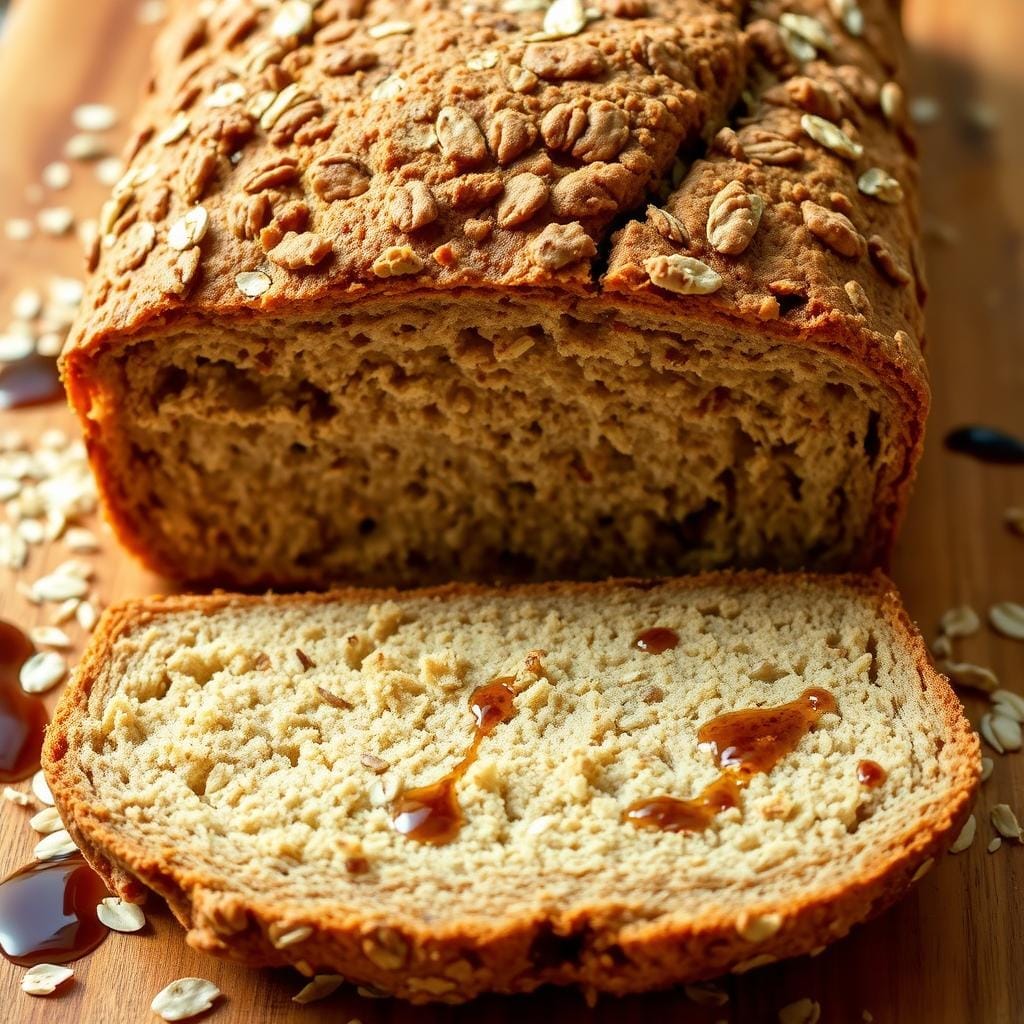
Oatmeal molasses bread has a rich history in traditional baking. It combines oats’ nutty flavor with blackstrap molasses’ deep taste. This creates a tender, slightly sweet bread that’s a joy to eat.
History of Molasses Bread Making
Molasses has been used in baking for centuries. Early American cookbooks had recipes for molasses bread and cakes. Blackstrap molasses was especially popular for its flavor and moisture. Oats, too, have been a staple, adding texture and nutrition to breads.
Benefits of Homemade Bread
- Whole grain goodness from the oats
- Natural sweetness and moisture from the molasses
- Customizable flavors and ingredients
- Absence of preservatives and artificial additives
- Cost-effective compared to store-bought options
Why This Recipe Works
This recipe balances whole grains and all-purpose flour for a nutritious, soft loaf. Molasses gives it a unique flavor and keeps it moist. Oats add a chewy texture and nutty taste. With simple ingredients, you can make a delicious, homemade bread that everyone will love.
Essential Ingredients for Perfect Results
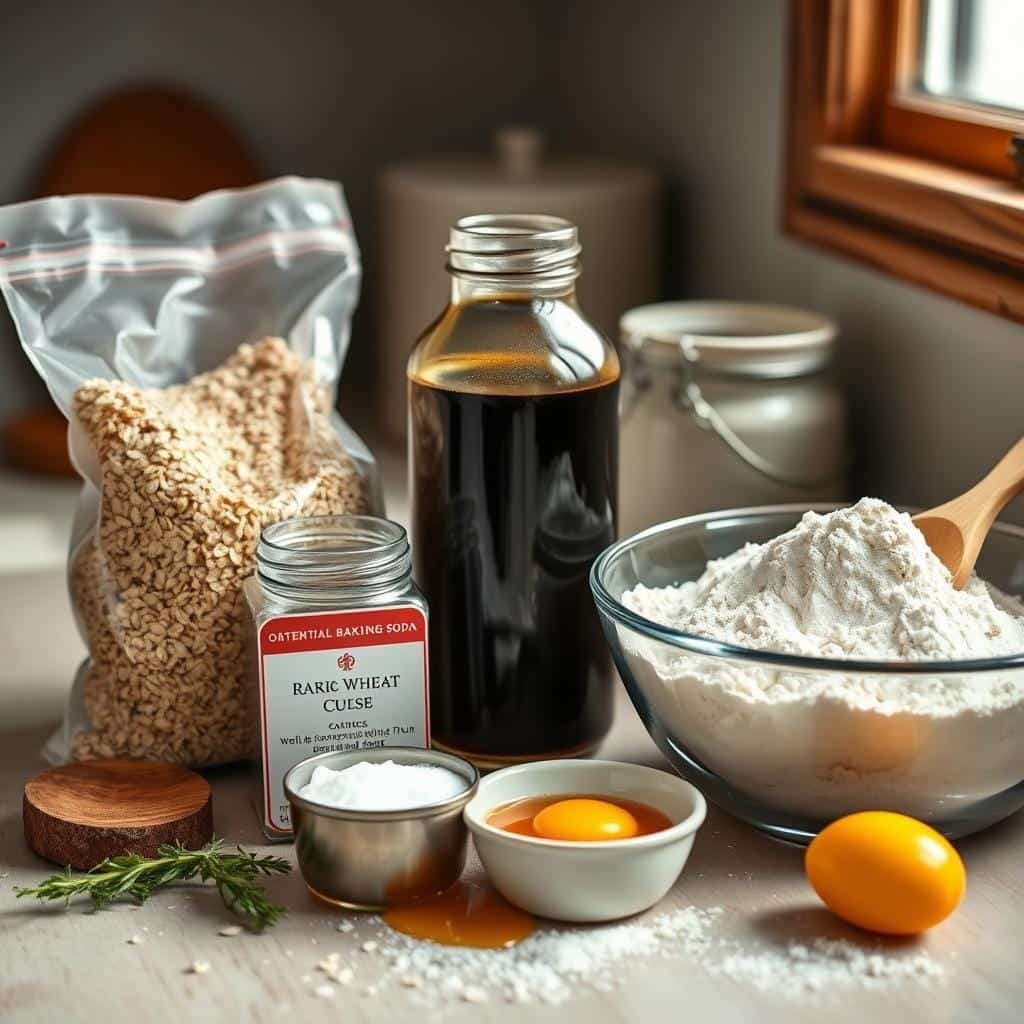
Making the perfect oatmeal molasses bread starts with the right ingredients. This recipe combines whole grains, sweeteners, and leavening agents. Let’s look at the key ingredients that make this bread special.
The recipe uses large-flake rolled oats for a hearty flavor and texture. Fancy molasses adds a rich, indulgent taste. Together, they create the bread’s unique flavor.
The recipe also includes whole wheat flour and all-purpose flour. Whole wheat flour adds fiber and a nutty taste. All-purpose flour makes the bread soft and tender. Active dry yeast helps the dough rise into a beautiful loaf.
Eggs, sugar, salt, and butter complete the list. They add richness, sweetness, and a tender crumb. With these ingredients, you’re ready to bake an exceptional oatmeal molasses bread.
| Ingredient | Amount |
|---|---|
| Quick-cooking oats | 1 cup |
| Fancy molasses | 1/2 cup |
| Whole wheat flour | 2 cups |
| All-purpose flour | 2 cups |
| Active dry yeast | 2 1/4 teaspoons |
| Eggs | 2 |
| Sugar | 2 tablespoons |
| Salt | 1 teaspoon |
| Butter | 2 tablespoons |
Kitchen Tools and Equipment Needed
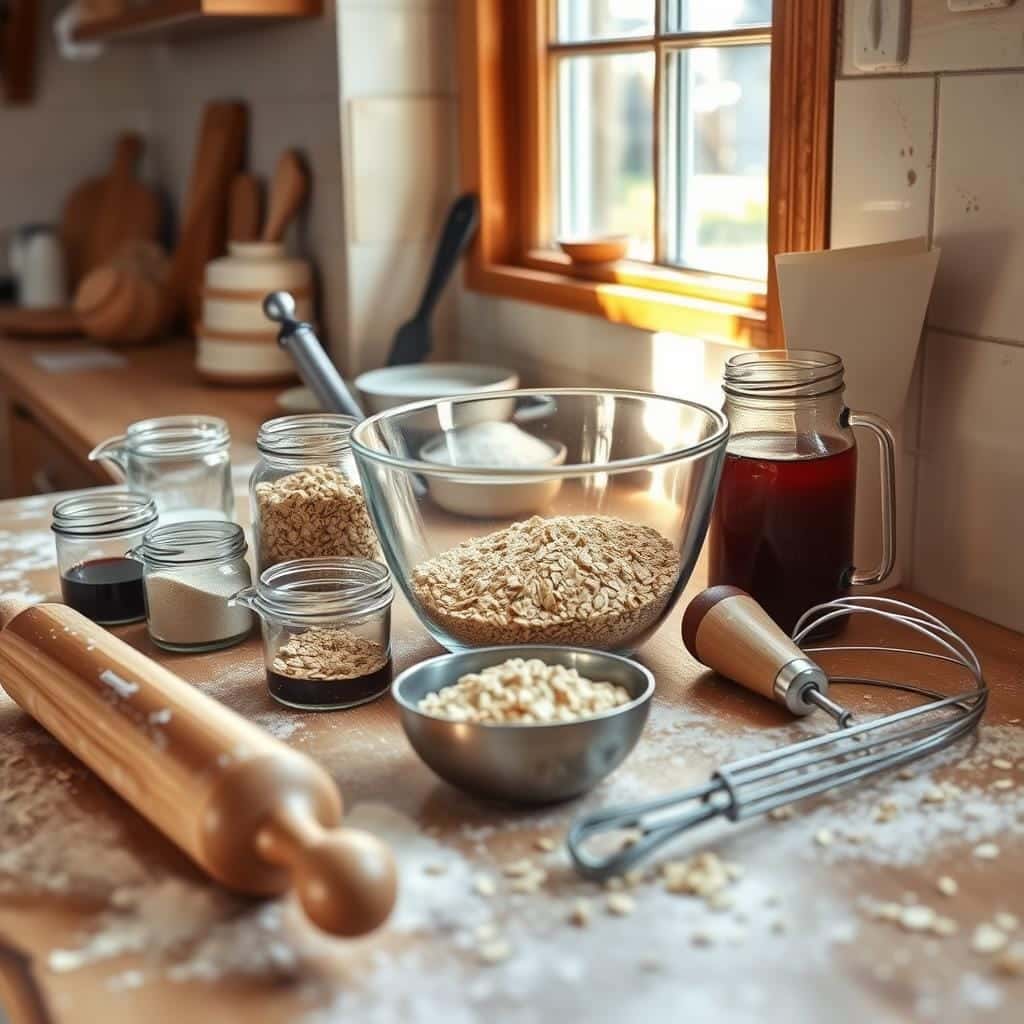
Baking homemade oatmeal molasses bread needs some basic tools and equipment. Having the right kitchen essentials makes the process smoother and ensures great results every time.
Essential Baking Tools
- Bread pans (8×4 inch or 9×5 inch) for shaping and baking the loaves
- Mixing bowls of various sizes for preparing the dough
- Wooden spoon or sturdy spatula for mixing and kneading the dough
- Measuring cups and spoons for accurately measuring ingredients
- Stand mixer (optional, but greatly helpful for kneading the dough)
Optional but Helpful Equipment
- Instant-read thermometer to ensure the bread is baked to perfection
- Dough scraper or bench knife for shaping and dividing the dough
- Parchment paper or silicone baking mats for lining the bread pans
- Spray bottle for misting the oven during baking to create a crisp crust
Measuring Tools
Getting the right measurements is key for the perfect oatmeal molasses bread. Make sure you have these tools:
- Dry measuring cups for ingredients like flour, oats, and sugar
- Liquid measuring cups for measuring liquids like water, milk, and molasses
- Measuring spoons for precise amounts of salt, baking soda, and yeast
With the right tools and measuring equipment, you’re ready to make the perfect oatmeal molasses bread. Proper preparation is the secret to a successful baking experience.
Preparing the Oat and Molasses Base
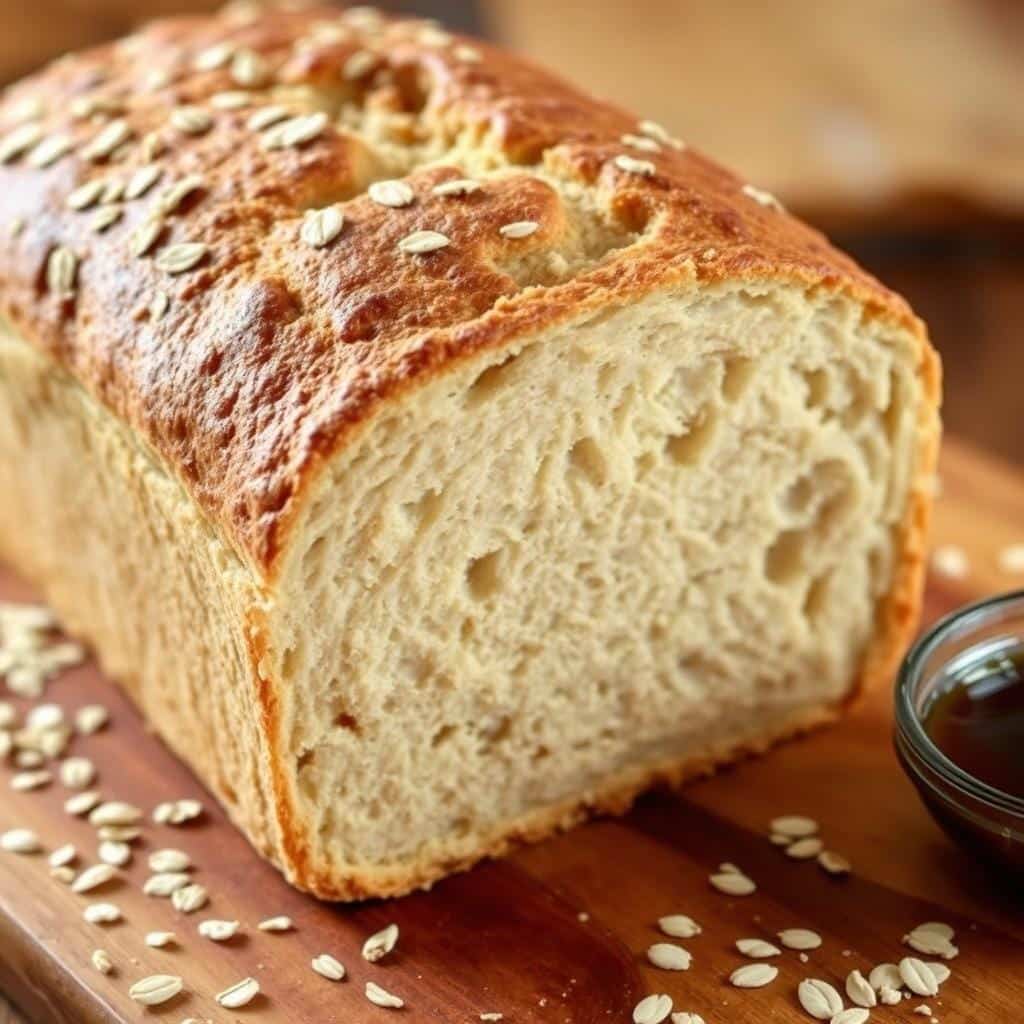
The start of a tasty oat flour bread is in making the oat and molasses base. This step is key for the bread’s rustic flavor and soft texture.
Start by soaking rolled oats in boiling water for about 15 minutes. This makes the oats soft and easy to mix into the dough. After soaking, let the oats cool down before moving on.
- Measure out the needed molasses and warm it until it’s easy to pour.
- Mix in the melted butter and a beaten egg with the cooled oats. Stir until everything is well mixed.
- Make sure the oat-molasses mix is not too hot before adding the yeast. Hot mix can kill the yeast, which is bad for the bread’s rise.
| Ingredient | Quantity |
|---|---|
| Rolled Oats | 1 cup |
| Boiling Water | 1 cup |
| Molasses | 1/4 cup |
| Unsalted Butter, Melted | 2 tbsp |
| Egg, Beaten | 1 |
Preparing the oat and molasses base is crucial for a great oat flour bread. The soaked oats and molasses give a strong base. The butter and egg make the bread soft and tender. With this base done, you’re ready for the next steps.
Proper Yeast Activation Techniques
Getting your yeast to activate right is key for a great rise and texture in oatmeal molasses bread. It’s a simple process, but getting the temperature just right is crucial. This ensures your yeast is ready to work its magic.
Temperature Considerations
Yeast loves warmth, so use lukewarm water (around 105°F) when proofing it. Water that’s too hot can kill the yeast. Water that’s too cold won’t activate it right. Make sure to check your water’s temperature before adding the active dry yeast and sugar.
Signs of Active Yeast
- After about 10 minutes, you should see the mixture start to foam and bubble. This means the yeast is alive and ready to work.
- If the mixture stays flat and inactive, your yeast might be expired or the water was the wrong temperature. You’ll need to start the yeast activation again.
Watching the rising time and looking for these signs will help your oatmeal molasses bread dough rise perfectly. This leads to a light and fluffy loaf every time.
Mixing and Kneading Methods
Making homemade bread is all about mastering mixing and kneading. These steps are key to creating the right dough consistency. They help develop the gluten structure.
Start by mixing dry ingredients like flour in a big bowl. Then, add wet ingredients like oatmeal and molasses slowly. Use a spoon or a stand mixer with a kneading hook. Keep adding flour a bit at a time until the dough sticks to the hook and cleans the bowl.
- Don’t over-knead the dough. A quick kneading of about 1 minute on a floured surface is enough.
- The dough should feel moist but not sticky. It should be smooth and elastic.
- Good kneading techniques are crucial. They make the dough elastic and trap air, creating the right dough consistency.
“The key to perfect bread lies in the balance of the dough – not too dry, not too wet, but just right.”
Learning to mix and knead is key to making great oatmeal molasses bread. With practice, you’ll get the hang of it. Your dough will be easy to work with and bake beautifully.
The Art of Dough Rising
Mastering dough rising is key to making perfect oatmeal molasses bread. This step lets yeast work its magic. It turns simple ingredients into a light, airy, and flavorful loaf. Let’s explore the first and second rises to help your bread reach its best.
First Rise Tips
After kneading, put the dough in a lightly greased bowl. Cover it with plastic wrap or a damp towel. Let it rise in a warm, draft-free area until it doubles in size. This usually takes 60-75 minutes, depending on your kitchen’s temperature.
Watch the dough closely. Rising time can change due to temperature and humidity.
Second Rise Guidelines
After the first rise, gently punch down the dough. This releases trapped air bubbles. Shape the dough into loaves and put them in greased pans. Cover the pans and let it rise again until it doubles in size and crests about 1 inch above the pan rim.
This second rise takes 30 to 60 minutes, depending on your kitchen’s temperature and humidity.
Proper rising time, dough fermentation, and proofing bread are crucial. They help achieve a light, airy texture and rich flavor in your homemade oatmeal molasses bread. By following these tips, your dough will rise perfectly. This will lead to a delightful baking experience and a satisfying final product.
Shaping and Preparing Loaves
Mastering bread shaping techniques is key for perfect loaf formation and that bakery-style bread texture. Here’s how to shape your homemade oatmeal molasses dough into beautiful loaves:
- Divide the dough into two equal pieces.
- Roll each piece into a rectangle, about 8×11 inches for 8×4 inch pans or 9×12 inches for 9×5 inch pans.
- Starting from the short side, tightly roll up the dough into a jelly-roll style shape.
- Pinch the seams to seal them.
- Place the shaped loaves, seam-side down, into greased baking pans.
Cover the pans with greased plastic wrap or a clean, damp tea towel. Let the dough rise for the second time. Follow the instructions from before. This second rise will help the loaf formation develop its perfect shape and structure. You’ll get a beautiful, bakery-style bread.
| Dough Size | Rectangle Dimensions | Pan Size |
|---|---|---|
| 2 equal pieces | 8×11 inches | 8×4 inch pans |
| 2 equal pieces | 9×12 inches | 9×5 inch pans |
“The secret to a perfect loaf formation lies in the attention to detail during the shaping process.”
Baking Temperature and Timing
Getting the baking temperature and timing right is key to making great oatmeal molasses bread. You need to preheat your oven to the perfect temperature. Then, watch the bread as it bakes.
Preheat your oven to 375°F (not fan-assisted) with the rack in the oven’s center. This temperature helps the bread bake evenly and get a golden-brown crust. After the oven is ready, put your bread dough in.
Bake the bread for about 40 minutes, checking it after 25 minutes. If the top browns too fast, cover it with foil to stop over-browning. The bread is ready when its internal temperature hits at least 200°F, checked with a food thermometer.
By sticking to these baking temperature and timing tips, your oatmeal molasses bread will turn out perfectly. It will have a golden-brown outside and a moist inside.
“Baking is both a science and an art, and getting the temperature and timing right is essential for achieving the perfect oatmeal molasses bread.”
Achieving the Perfect Crust and Texture
Baking the perfect oatmeal molasses bread is all about getting the crust and texture right. Look for a deep, golden brown crust that’s crisp but still soft. This is a sign your bread is perfectly baked and ready to enjoy.
Visual Cues for Doneness
Keep an eye on the crust as your oatmeal molasses bread bakes. The ideal color is a rich, golden brown. Don’t let the crust get too dark or dry, as it can taste bitter.
Use an oven light or open the oven door to check the crust’s progress.
Internal Temperature Guide
Visual cues aren’t enough – the internal temperature is key. Use an instant-read thermometer to check the temperature. It should be at least 200°F and up to 210°F for the best results.
The bread should also sound hollow when tapped on the bottom.
For a beautiful finish, brush the top with a beaten egg before baking. This makes the crust shiny and professional-looking. You can also sprinkle oats on top for extra texture and appeal.
By focusing on the bread crust, internal bread temperature, and bread texture, you can make perfect homemade oatmeal molasses bread every time. Enjoy the delicious results of your baking!
Storage and Freezing Tips
Keeping your homemade oatmeal molasses bread fresh is key. Whether you’re eating it now or saving it, the right storage and freezing methods are crucial.
Bread Storage at Room Temperature
For short-term storage, use an airtight container at room temperature. This keeps the bread moist and prevents drying. Your bread will stay fresh for 2-3 days.
Freezing Bread for Longer Shelf Life
Freezing is the best way to keep your bread fresh longer. Wrap it in plastic wrap or foil, or use a freezer bag. Frozen, your bread can last 2-3 months.
This recipe is great for making two loaves. Enjoy one now and freeze the other for later. This way, you can enjoy the fresh taste whenever you want.
“Freeze bread for up to 2-3 months to preserve its freshness and enjoy it long after baking.”
Thawing and Reviving Frozen Bread
- To thaw frozen bread, just put it in the fridge overnight.
- For a fresher taste, reheat thawed bread in a 350°F oven for 10-15 minutes.
- This method crisps the crust and makes the inside soft and fluffy again.
By using these simple storage and freezing tips, you can enjoy your homemade oatmeal molasses bread for days or weeks.
Serving Suggestions and Pairings
The breakfast bread made with oatmeal and molasses is very versatile. It’s perfect as a comfort food for breakfast or as a side for a savory meal. This hearty breakfast bread is a great choice.
Breakfast Ideas
To start your day, toast a slice of oatmeal molasses bread. Top it with creamy peanut butter or your favorite fruit preserves. The combination of warm bread, sweet flavors, and nuttiness is incredibly satisfying.
Or, enjoy the bread with a bigger breakfast. Slice it thick and serve it with scrambled eggs, crispy bacon, or warm oatmeal. It’s a filling and heartwarming way to begin your day.
Meal Accompaniments
The oatmeal molasses bread is great with savory dishes. It pairs well with a hearty stew or chili, enhancing the meal’s rich flavors.
For a cozy winter meal, try it with baked beans, roasted veggies, or a casserole. Its ability to soak up sauces makes it a perfect side dish.
Whether you enjoy it for breakfast or as a side, the oatmeal molasses bread is a favorite. It brings delicious, comforting flavors to your meals.
Conclusion
This oatmeal molasses bread recipe is a delightful and nutritious homemade option. It’s perfect for both experienced bakers and beginners. The mix of molasses and oats gives a rich, satisfying taste.
Mastering this recipe takes patience and the right techniques. You’ll learn how to activate yeast, shape the dough, and get that perfect crust. Let the aroma of freshly baked bread fill your kitchen.
Enjoy this versatile loaf for breakfast or as a side to your favorite meals. It’s a comforting and nutritious choice. This traditional bread baking recipe will become a favorite in your home.
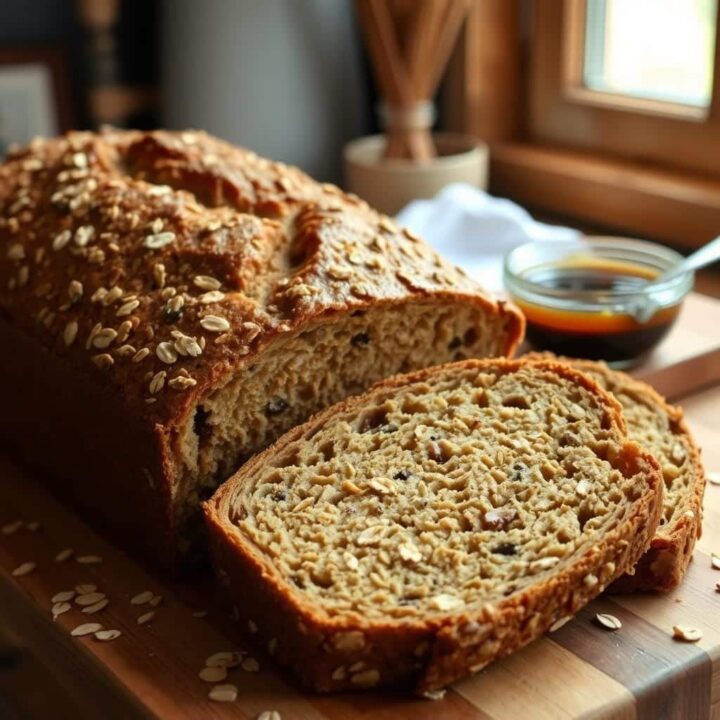
Oatmeal Molasses Bread
Indulge in the nostalgic aroma of freshly baked oatmeal molasses bread. This hearty loaf, a blend of oats and molasses, offers a comforting taste of tradition.
Ingredients
- 1 cup quick-cooking oats
- 1/2 cup fancy molasses
- 2 cups whole wheat flour
- 2 cups all-purpose flour
- 2 1/4 teaspoons active dry yeast
- 2 eggs
- 2 tablespoons sugar
- 1 teaspoon salt
- 2 tablespoons butter
Instructions
- Prepare the Oat and Molasses BaseSoak oats in boiling water for 15 minutes. Warm molasses and mix with melted butter and beaten egg.
- Activate the YeastIn lukewarm water, dissolve sugar and active dry yeast. Let stand for 10 minutes until foamy.
- Mix and Knead the DoughIn a large bowl, combine dry ingredients. Gradually add wet ingredients and mix until a dough forms. Knead for 1 minute on a floured surface.
- First RisePlace dough in a greased bowl, cover, and let rise in a warm place for 60-75 minutes, or until doubled in size.
- Shape the LoavesPunch down dough and divide into two equal pieces. Roll out each piece into a rectangle and roll up into a jelly-roll shape. Place in greased baking pans.
- Second RiseCover pans and let dough rise for 30-60 minutes, or until doubled in size and crests 1 inch above the pan rim.
- BakePreheat oven to 350°F (175°C). Bake for 30-35 minutes, or until golden brown and sounds hollow when tapped.
- CoolRemove from oven and let cool in pans for 10 minutes before slicing and serving.
Nutrition Information:
Yield: 16 Serving Size: 1Amount Per Serving: Calories: 187Total Fat: 3gSaturated Fat: 1gTrans Fat: 0gUnsaturated Fat: 1gCholesterol: 27mgSodium: 158mgCarbohydrates: 36gFiber: 3gSugar: 10gProtein: 5g
FAQ
What is oatmeal molasses bread?
Oatmeal molasses bread is a delicious, affordable bread. It mixes oats, molasses, and whole wheat flour. This recipe makes a soft, sweet loaf.
What are the key ingredients in this recipe?
You’ll need large-flake oats, fancy molasses, and whole wheat flour. Also, all-purpose flour, yeast, eggs, salt, sugar, and butter are important.
What are the benefits of making this bread at home?
Making oatmeal molasses bread at home is healthy and fun. It’s great for toast, sandwiches, or with butter. Plus, you get two loaves to freeze and bake later.
What kitchen tools and equipment are needed to make this bread?
You’ll need bread pans, measuring tools, bowls, and a stand mixer (if you have one). An instant-read thermometer is also key for checking if the bread is done.
How do you properly activate the yeast for this recipe?
Mix white sugar, lukewarm water, and yeast in a bowl. Wait 10 minutes for it to foam up. This shows the yeast is working.
What’s the best way to mix and knead the dough?
Use a spoon or stand mixer with a kneading hook. Add flour slowly until the dough is moist. Knead for just 1 minute on a floured surface.
How do you shape and bake the loaves?
Split the dough into two parts. Roll each into a rectangle and roll up. Place in greased pans and let rise. Bake at 375°F for 40 minutes, until it’s 200°F inside.
How should the baked bread be stored?
Keep the bread in an airtight container at room temperature for 2-3 days. Freeze for up to 2-3 months for longer storage.
What are some serving suggestions for this oatmeal molasses bread?
Enjoy it with peanut butter or jam for breakfast. It’s also good with baked beans, stews, or as a side for winter meals. Toast it and add butter or molasses for a special treat.





